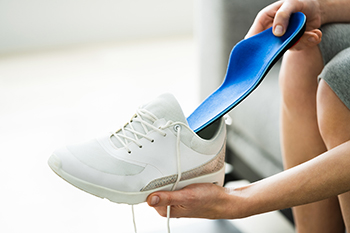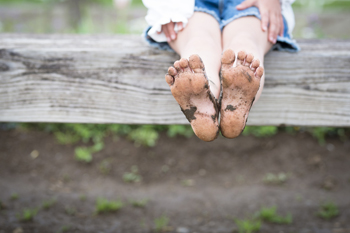Items filtered by date: January 2023
Salicylic Acid on Corns

Corns on the feet, although not always a serious condition, can still cause patients discomfort and annoyance because of their unsightly look. Corns are essentially defined as tough or hardened areas of the skin on the feet that develop in response to friction and pressure. Many individuals with corns on the feet are interested to know how salicylic acid can be used to treat this condition. Interestingly, this acid is known as a keratolytic, and so a medical professional may use it to dissolve the substances that compose the corn on the feet. Specifically, the salicylic acid can be used to dissolve proteins that make up the corn. It is important to note that salicylic acid is made in a variety of concentrations that will all have different effects on the removal of the corn. Schedule an appointment with a podiatrist to learn more about this and to treat your corns.
If you have any concerns regarding your feet and ankles, contact James Pak, DPM of California. Our doctor will treat your foot and ankle needs.
Corns: What Are They? and How Do You Get Rid of Them?
Corns can be described as areas of the skin that have thickened to the point of becoming painful or irritating. They are often layers and layers of the skin that have become dry and rough, and are normally smaller than calluses.
Ways to Prevent Corns
There are many ways to get rid of painful corns such as wearing:
- Well-fitting socks
- Comfortable shoes that are not tight around your foot
- Shoes that offer support
Treating Corns
Treatment of corns involves removing the dead skin that has built up in the specific area of the foot. Consult with Our doctor to determine the best treatment option for your case of corns.
If you have any questions please feel free to contact our office located in Anaheim, CA . We offer the newest diagnostic and treatment technologies for all your foot and ankle needs.
Keep Your Feet Healthy So You Can Stay Active
How Being Overweight Can Affect Your Feet

Being overweight can contribute to the development of foot problems in several ways. Carrying excess weight can negatively affect the structure of your feet, especially in the heels. It also increases the pain and discomfort of arthritis. The more extra weight you carry, the worse any foot ailment becomes. Being overweight can result in overuse foot problems, such as tendonitis, stress fractures, and plantar fasciitis or other heel pain. It is also believed that excess weight increases your chances of developing high cholesterol, poor circulation, and diabetes. These conditions can have a direct result on damage to your feet. The main ways to reduce the effects of obesity is to become more physically active, find an eating plan that allows you to lose weight gradually, and make some lifestyle changes regarding food habits. If you have foot pain that is a direct result of excessive body weight, it is a good idea to consult a podiatrist who can examine your feet and ankles and offer appropriate treatment options.
Obesity has become very problematic at this point in time and can have extremely negative effects on the feet. If you’re an obese individual and are concerned about your feet, contact James Pak, DPM from California. Our doctor can provide the care you need to keep you pain-free and on your feet.
Obesity and Your Feet
Since your feet are what support your entire weight when standing, any additional weight can result in pain and swelling. Being overweight is one of the main contributors to foot complications.
Problems & Complications
Extra Weight – Even putting on just a few extra pounds could create serious complications for your feet. As your weight increases, your balance and body will shift, creating new stresses on your feet. This uneven weight distribution can cause pain, even while doing the simplest tasks, such as walking.
Diabetes – People who are overweight are at serious risk of developing type-2 diabetes, which has a drastic impact on the health of your feet. As you get older, your diabetes might worsen, which could lead to loss of feeling in your feet, sores, and bruises. You could also become more prone to various infections.
Plantar fasciitis – Pressure and stress that is placed on muscles, joints, and tendons can trigger plantar fasciitis, which is an inflammation of tissue that forms along the bottom of the foot.
If you have any questions please feel free to contact our office located in Anaheim, CA . We offer the newest diagnostic and treatment technologies for all your foot and ankle needs.
Types of Insoles

Foot pain can be caused for a variety of reasons, but ill-fitting shoes are the biggest culprit. And if shoe fit is the reason for foot pain, insoles can be the first line of defense. Insoles are the soft cushions that fit inside most shoes. They work as shock absorbers for the feet. If one wears the same shoe every day, the insoles can start to break down and may need to be replaced. There are different insoles for different needs. An insert, insole, and orthotic are often terms that are used interchangeably, however, they are different. An insert is a thin piece of shoe padding or gel cushion that is placed in shoes to provide relief to pain in heels, arches, and forefeet. They are used for shock absorption, cushioning against pressure, and keeping the feet supported while walking. Insoles are general-purpose, off-the-shelf overlays for shoes that are made of foam. Orthotics are customized inserts that are used to control movement in the feet and legs. They are typically made to order. Visiting a podiatrist is suggested for the proper determination of the best type of insole for your foot discomfort.
Foot Pain
Foot pain can be extremely painful and debilitating. If you have a foot pain, consult with James Pak, DPM from California. Our doctor will assess your condition and provide you with quality foot and ankle treatment.
Causes
Foot pain is a very broad condition that could be caused by one or more ailments. The most common include:
- Bunions
- Hammertoes
- Plantar Fasciitis
- Bone Spurs
- Corns
- Tarsal Tunnel Syndrome
- Ingrown Toenails
- Arthritis (such as Gout, Rheumatoid, and Osteoarthritis)
- Flat Feet
- Injury (from stress fractures, broken toe, foot, ankle, Achilles tendon ruptures, and sprains)
- And more
Diagnosis
To figure out the cause of foot pain, podiatrists utilize several different methods. This can range from simple visual inspections and sensation tests to X-rays and MRI scans. Prior medical history, family medical history, and any recent physical traumatic events will all be taken into consideration for a proper diagnosis.
Treatment
Treatment depends upon the cause of the foot pain. Whether it is resting, staying off the foot, or having surgery; podiatrists have a number of treatment options available for foot pain.
If you have any questions, please feel free to contact our office located in Anaheim, CA . We offer the newest diagnostic and treatment technologies for all your foot care needs.
Treatment Methods for a Broken Toe

A common reason people may break their toe is from stubbing it into a wall or piece of furniture. This can cause the toe to immediately become bruised, swollen, and extremely painful. Dropping a heavy object on the toe may cause it to become fractured, and medical attention is often sought for relief. If the break is severe, a bone may protrude from the skin, often causing the toe to appear deformed. One of the first things to do if a broken toe has happened is to refrain from putting weight on it. This is done by frequently elevating the affected foot and choosing effective treatment methods. Mildly broken toes may benefit from using the buddy-taping method. This is done by taping the broken toe to the toe next to it, which is often adequate in providing the necessary support as it heals. Severely fractured toes may require a cast or a protective boot to be worn, and a podiatrist can determine which treatment method is best for you.
Broken toes may cause a lot of pain and should be treated as soon as possible. If you have any concerns about your feet, contact James Pak, DPM from California. Our doctor will treat your foot and ankle needs.
What Is a Broken Toe?
A broken toe occurs when one or more of the toe bones of the foot are broken after an injury. Injuries such as stubbing your toe or dropping a heavy object on it may cause a toe fracture.
Symptoms of a Broken Toe
- Swelling
- Pain (with/without wearing shoes)
- Stiffness
- Nail Injury
Although the injured toe should be monitored daily, it is especially important to have a podiatrist look at your toe if you have severe symptoms. Some of these symptoms include worsening or new pain that is not relieved with medication, sores, redness, or open wounds near the toe.
If you have any questions, please feel free to contact our office located in Anaheim, CA . We offer the newest diagnostic and treatment technologies for all your foot care needs.
Pay Attention to Children’s Foot Problems

Children’s foot problems often go undiagnosed because parents do not know what to pay attention to, or they believe their kids will outgrow the problems. Ankle and foot ailments can be common in children because they are so physically active, but it can be easy to overlook these things because kids are so resilient. Parents should watch for symptoms of common foot and ankle problems among children. These problems include ankles turning in more than usual, pain, the arch of the foot flattening, cramping, limping, or a change in the activity level of the child. Children who participate in sports are most apt to experience foot and ankle issues. If your child exhibits the symptoms described above, consult with a podiatrist so that the risk of problems turning into more serious or chronic conditions is mitigated.
The health of a child’s feet is vital to their overall well-being. If you have any questions regarding foot health, contact James Pak, DPM of California. Our doctor can provide the care you need to keep you pain-free and on your feet.
Tips for Keeping Children's Feet Healthy
- Make sure their shoes fit properly
- Look for any signs of in-toeing or out-toeing
- Check to see if they have Clubfoot (condition that affects your child’s foot and ankle, twisting the heel and toes inward) which is one of the most common nonmajor birth defects.
- Lightly cover your baby’s feet (Tight covers may keep your baby from moving their feet freely, and could prevent normal development)
- Allow your toddler to go shoeless (Shoes can be restricting for a young child’s foot)
- Cut toenails straight across to avoid ingrown toenails
- Keep your child’s foot clean and dry
- Cover cuts and scrapes. Wash any scratches with soap and water and cover them with a bandage until they’ve healed.
If you have any questions, please feel free to contact our office located in Anaheim, CA . We offer the newest diagnostic and treatment technologies for all your foot care needs.

